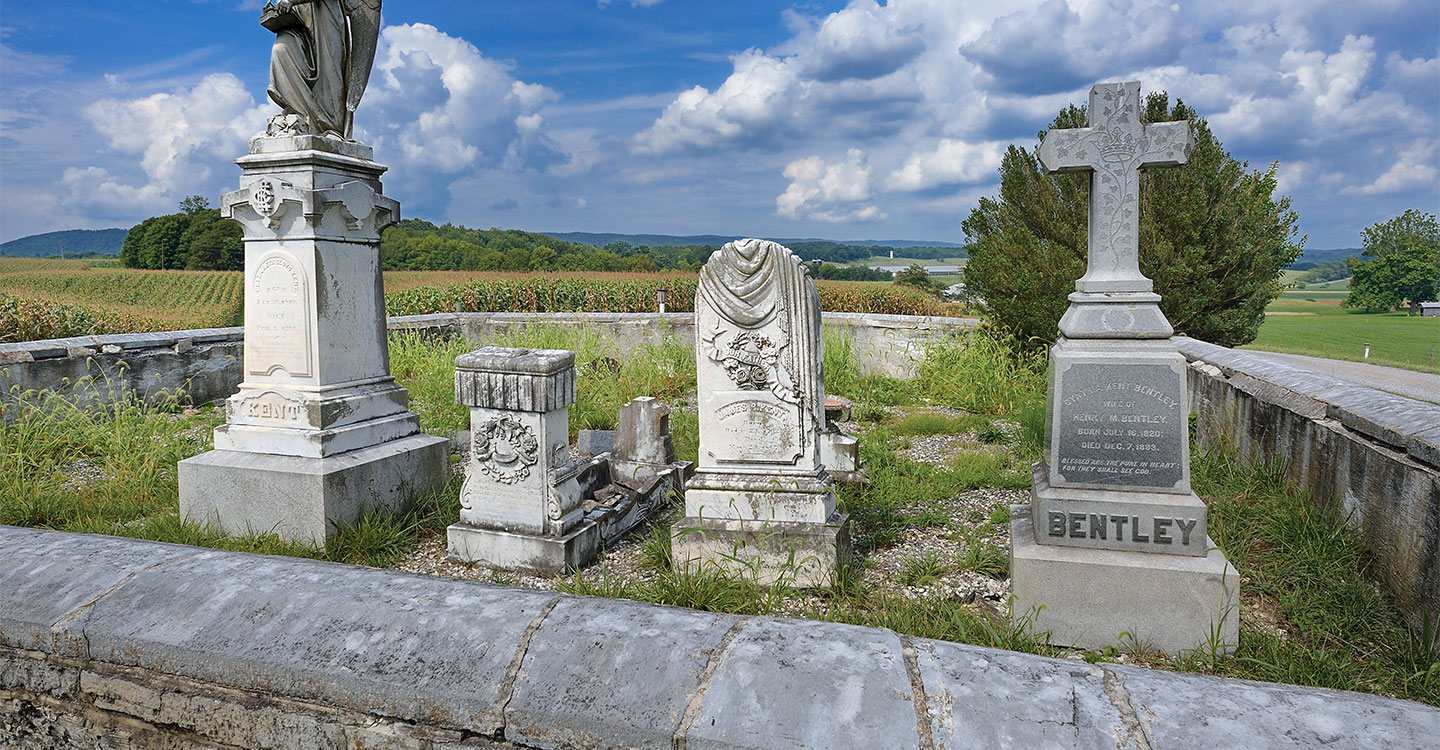by Mason Adams
On a list of the most well-known Virginia Tech landmarks, there's one thing you probably won't find: cemeteries.
Well before Blacksburg birthed an internationally renowned research university, the deceased were being laid to rest in the Preston Cemetery at Historic Smithfield Plantation.
Well before nearby Kentland Farm became home to an agricultural experiment station, dairy science complex, and more, the land held two cemeteries, one for the Kent family and one for slaves.
The lives of the dead tell us not just about Virginia Tech's origins but also about the roots of Southwest Virginia history as we know it.
At the Preston site, on a hill northeast of the Southgate Drive and U.S. Route 460 intersection, gravestones honor a Virginia governor, a secretary of the U.S. Navy, numerous Confederate military officers, six generations of the Preston family, at least two slaves, and more. Even into the 21st century the Prestons continue to use the cemetery, with individuals interred there as recently as 2008.
"If it wasn't for the Preston family, there probably wouldn't be a Virginia Tech here," said Laura Wedin (M.F.A. theatre arts '84), the Alumni Association's alumni/student programs director, who has conducted extensive research on the cemetery. The Olin and Preston Institute (later renamed the Preston and Olin Institute), a Methodist academy that opened in 1851, "was the precursor to Virginia Tech," Wedin said.
Anna Whitehead Kenney, the first curator at Smithfield, researched the land and families who lived there. Wedin and other historians and archaeologists have continued that work, though some of the Preston Cemetery's mysteries endure.
Selected stories from Preston Cemetery:

The Preston Cemetery at Historic Smithfield Plantation; photo by Jim Stroup
William Preston (1730-1783)
Col. William Preston, a Revolutionary War leader and patriot, became the patriarch of the Preston family. His wife, Susanna, outlived him by 40 years, but asked to be placed in the same grave, creating a Preston family tradition. Their resting place is marked by a marble slab that was made in Philadelphia and shipped to Smithfield nine years after Susanna's death and nearly a half-century after the colonel's.
James Patton Preston (1774-1843)
The fourth son of William and Susanna Preston, James inherited Smithfield at age 9 when his father died. James fought in the War of 1812 and a few years later was elected governor of Virginia, serving from 1816 to 1819. His wife, Ann, died 18 years after he did, and was buried in the same grave as her husband.
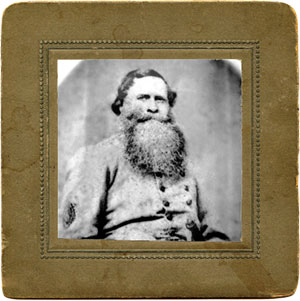
Robert Taylor Preston (1809-1880)
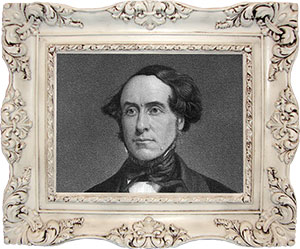
William Ballard Preston
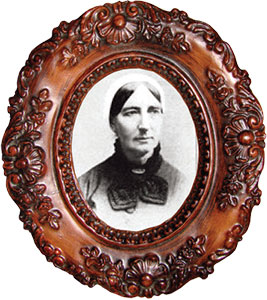
Sarah Ann Caperton (1826-1908)
Robert Taylor Preston (1809-1880)
Robert Taylor Preston—a son of James Patton Preston and brother to William Ballard Preston, the namesake of the Olin and Preston Institute—served as a colonel during the Civil War. Apparently, he was completely inept as a military commander, Wedin said, but his troops loved him. Afterward, he retired to the Solitude home—today, the oldest structure on campus, believed to date back more than 200 years. In 1872, Preston sold the house and surrounding acreage to the newly created Virginia Agricultural and Mechanical College (today's Virginia Tech). John Sargent Wise's 1899 book "End of An Era" described Preston as short and thick-set with an "immense snow-white beard" that he often tucked into his waist-coat.
Sarah Ann Caperton (1826-1908)
Sarah Ann Caperton outlived her husband, James Francis Preston (a son of James Patton Preston), by 46 years. She was photographed holding the body of her 2-year-old son, Jimmie, who had died of scarlet fever and is also buried in the cemetery. For parents of the era, such photography was an important way to remember deceased children.
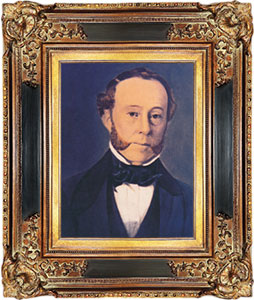
James Francis Preston

Sarah Ann Caperton with son, Jimmie
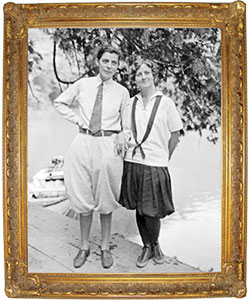
Sarah Caperton Preston (1885-1965)
Katherine Stuart Preston (1894-1967)
Sarah Caperton Preston (1885-1965) and Katherine Stuart Preston (1894-1967)
These two sisters, unmarried and buried together, stand out for their accomplishments during an era in which women were afforded few professional opportunities. They came of age during the roaring '20s. Sarah (at right in the image) opened a dance school in Norfolk, Virginia, while Katherine (at left) worked as a nurse and horsewoman at Camp Carysbrook, which was located in Wytheville, Virginia, before being relocated to Riner, Virginia. Katherine, regarded as the kinder of the two, asked to have her coffin placed beneath her sister's since the elder sister was stronger and more gracious, Wedin said.
Julia Binners (buried Christmas Day 1859)
Binners had no family connection with the Prestons. She was born in the West Indies to a wealthy planter family that lost its fortune after the abolition of slavery there. After her parents died, she taught at a girls' school in Chatham, Virginia, until she grew old and ill and came to Smithfield in 1859, perhaps to prepare for her death.
Virginia "Aunt Ginny" Fraction Capers
Capers was a former slave who became a child-minder for Hugh and Cary Preston in the late 19th and early 20th centuries. Capers became the keeper of the Preston family's oral histories, and her burial within the cemetery appears to signify her importance to the family, Wedin said. Even so, her status as a former slave makes it difficult to find other documentation about her life.
Benjamin
Benjamin is one of the Smithfield cemetery's more intriguing mysteries. A limestone marker hewn into the shape of a shield is inscribed with the name and a short epitaph that suggests Benjamin died as an infant. The difference between the handmade marker and the predominantly formal ones elsewhere suggests that Benjamin was the child of a slave, servant, or overseer.
Kentland Farm cemeteries
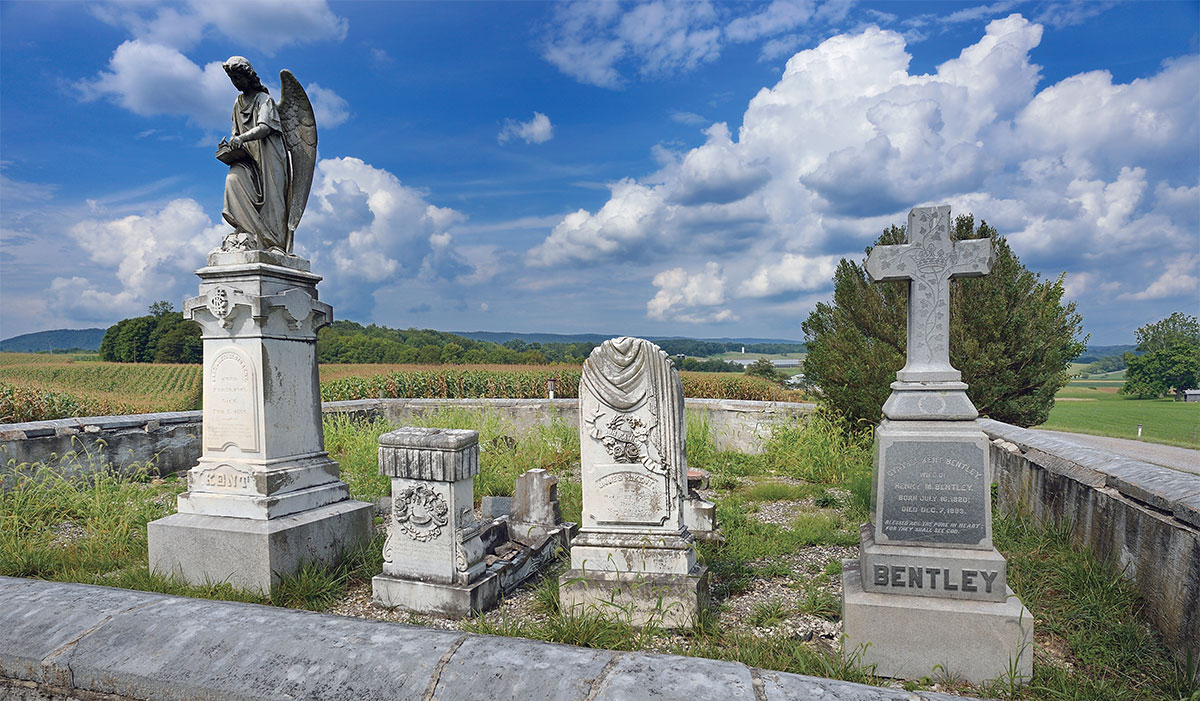
The family cemetery at Kentland Farm tells the tales of those who walked the region before us, such as James Kent (third stone from left), one of the region's most influential 19th-century residents. Photo by Jim Stroup.
About 8 miles west of Virginia Tech's Blacksburg campus is Kentland Farm, the new home of Tech's dairy science complex, among other university programs. In the mid-18th century, the historic plantation sat at the end of the Shenandoah Indian Road, marking the edge of European settlement. Even earlier, the area housed a Native American village between 900 and 1500 A.D., and artifacts found on the land may point to settlements there in 8000 B.C.

James Kent
In the early 1800s, James Kent acquired the farm by dowry; and by 1860, he owned more than 6,000 acres and 120 slaves, making him Montgomery County's richest man. Two cemeteries at Kentland that date from the era—the Kent family cemetery and a slave cemetery—sit equidistant from the plantation house, forming a triangle when viewed from above. The Kent family cemetery, much like the Preston cemetery, is fairly well documented as the burying ground for one of the most prominent families of 18th-century Montgomery County.
The slave cemetery, though much less documented, plays a crucial role in the history of the New River Valley's black population. Kent died in 1867, two years after the Civil War brought emancipation to the slaves. Many black residents had previously left with Union armies that passed through the area after the Battle of Cloyd's Mountain in May 1864, but others remained.
Eventually, former slaves settled in the Wake Forest community, along what is now McCoy Road, acquiring land there partly by purchase from the McCoy family and partly by bequest from Elizabeth Kent, James Kent's daughter, who had inherited Kentland after her father's death.
The physical evidence of the farm's slavery history has largely fallen away. The former slave quarters were dismantled, and the slave cemetery was nearly forgotten as the land was turned over to grazing livestock. However, Frank Bannister, the grandson of a former slave and a former Kentland employee himself, shared his memories of the plantation setup with local historian Jimmie Price in 1991.

After an excavation in 2004, state archaeologist Thomas Klatka showed the grave shafts to Tech students and Wake Forest residents. Photo courtesy of Sam Cook.
Bannister's memories and Price's work led to archaeological digs in 2004 and 2005 conducted by Sam Cook, an associate professor of sociology; students in Cook's Appalachian communities class; Thomas Klatka, an archaeologist with the Virginia Department of Historic Resources; and others. By using targeted digging to excavate trenches and tracking changes in the color, density, and organic content of the soil, they were able to map evidence of 23 graves, containing 18 adults, three children, and two infants.
"Most of my students had never had any exposure to archeology," Cook said. "What ultimately grabbed the students the most was the experience of actually seeing the descendants of the people there. That made what they were doing real."
Past and present
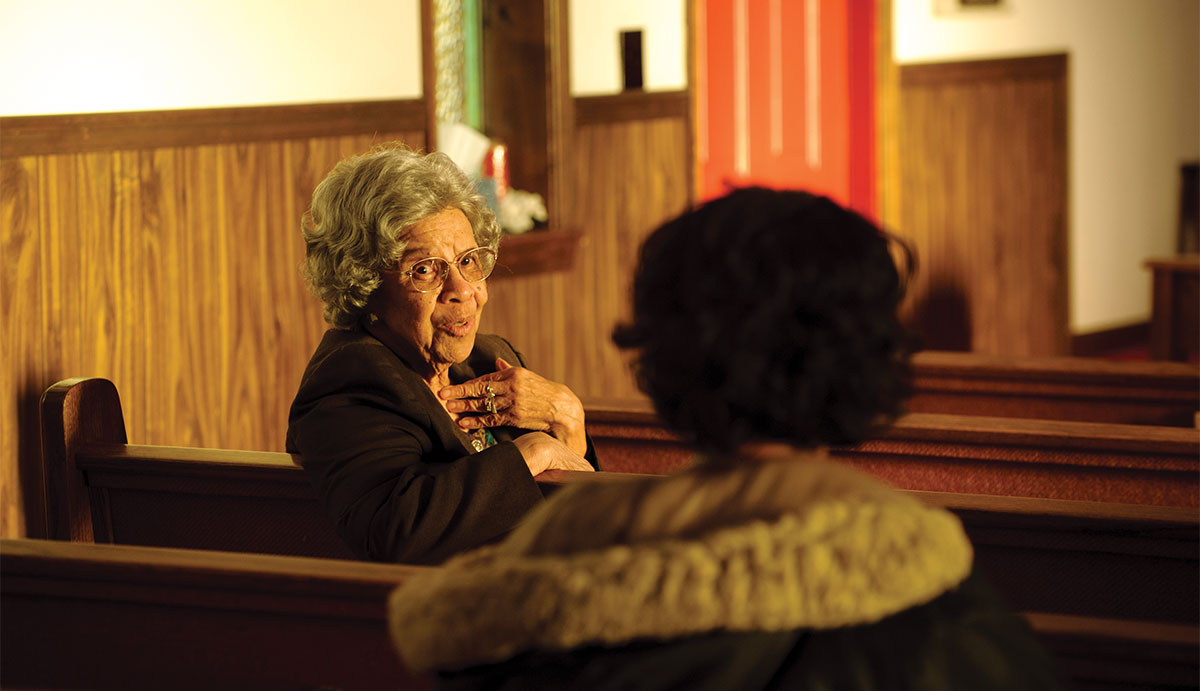
Esther "Queen" Jones in the Wake Forest church; photo by John McCormick
Esther "Queen" Jones, the Wake Forest community's 96-year-old matriarch, was born at the foot of Brush Mountain, about a mile and a half past the community. She married Howard Jones, who owned a coal mining company, and they moved into the house where Esther still lives today.
Esther Jones can recall her mother and grandmother, but she doesn't remember much more than that, nor did she press her ancestors for details. "People had too much on their minds to dig too far back," Jones said.
Many of the former slaves were skilled craftsmen who had performed high-quality, artisanal work. During the days of slavery, they were often loaned out both to other plantations for their specialized skills and to public works projects in Montgomery County. At Kentland Farm, they made their own bricks, designed a smokehouse, and built the plantation house with a removable roof so the slate easily could be repaired and maintained when needed.
"One of the things I always tell students and young people is to look at the brick in this house," said Cook while standing in the plantation house. "Every single one of those bricks was cast by hand by a slave. If you look very closely, you will see the fingerprint of someone who had no freedom in this country."
Once emancipated, the former slaves used those same skills to build the Wake Forest community and make it self-sufficient. Its residents took on the jobs that any small town needs: midwife, veterinarian, undertaker, blacksmith, stonemason, barber. A couple of people had cars and regularly transported their neighbors into Blacksburg for errands.
Charles Johnson, the founder of Blacksburg's New Image Barber Stylists and a participant in the integration of Blacksburg in the early '60s, traces his family back to his great-great-grandmother who was likely a slave at Kentland Plantation.
Johnson, who grew up on McCoy Road, remembers a steady stream of transients passing through during the mid-20th century, especially during the Great Depression. Many of them stayed at a hobo camp between Wake Forest and the train tracks, though others found temporary homes through the kindness of residents. A few even stayed, such as Albert Crill, a carpenter who built the original two-room house, since expanded, where Jones still lives.
The community claims a few early examples of integration, even during the Jim Crow era. The coal company owned by Esther's husband, Howard Jones—first the Fear Jones Eaves Coal Co. and later the Jones Coal Co.—employed about 20 black and white workers, some of whom commuted to work via canoe. The community churches served mixed congregations as well.
"I have known these women
"I have known these women
Have loved and admired them
Have loved and admired them
Have been afraid of and for them."
Have been afraid of and for them."
— From "These Women" by University Distinguished Professor Nikki Giovanni, about the women of the Wake Forest community
Wake Forest remains a small community today, but its descendants have spread across the U.S., living in Arkansas, California, Iowa, North Carolina, Ohio, South Carolina, Texas, and Washington, D.C.
The archaeological identification of the Kentland slave cemetery sparked renewed interest in exploring ancestral roots. Jones' daughter, Jean Eaves, began an extensive exploration of her family's genealogy and that of other Wake Forest families: the Eaves, the Bannisters, the Shermans, the Joneses, the Jacksons, the Pages, and others. The fruits of that research now reside in a community museum in the Wake Forest Holiness Church.
Both the museum and the cemetery have become destinations during periodic family reunions, when descendants of those first families, some of whom have never visited Wake Forest, explore their family histories and the legacy of slavery at Kentland Farm.
"I was intrigued by [the cemetery]," said Howard Eaves, Jones' son-in-law. "We had moved from here in 1959, when I was still in high school. It opened up the history for me. I started seeing things fall into place."
Jones' granddaughter, Tracie Edmond (accounting '86), sees the cemetery as an important and intriguing part of her family history. "I'm amazed at our history, to see how our family came together and how far back we actually went," Edmond said.
The genealogical exploration has tightened the bonds between Edmond and her family, especially her grandmother. She credits Jones, who shared a friendship with university President Emeritus T. Marshall Hahn Jr., for getting her into Virginia Tech. Edmond recently recognized another link, drawing a line from her grandmother's job bookkeeping for the Jones Coal Company with her own career as an accountant.
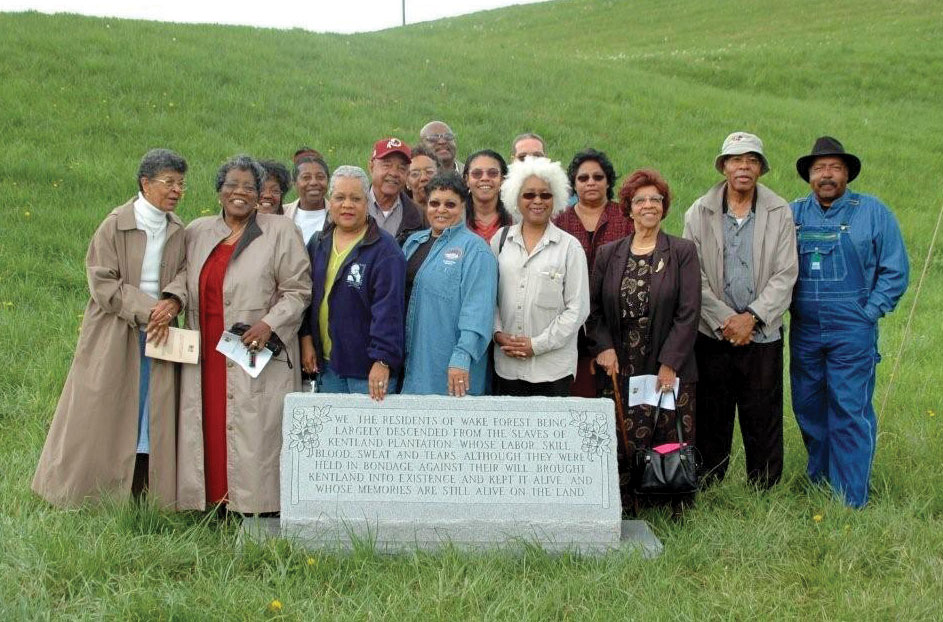
Members of the Wake Forest community gathered during a 2005 monument dedication at Kentland.
For Cook, the ties between the people buried in the slave cemetery and the living Wake Forest community are crucial to understanding the world in which we live. In April 2005, the community dedicated a monument that sits below the cemetery and bears an inscription written by Jones.
"All the elders from Wake Forest laid a rose at the bottom of that monument below the slave cemetery," Cook said of the dedication. "Big, grown men were just heaving with emotion like I'd never seen. It really brought it home. It holds us accountable. We understand that we exist today because people suffered. We can make a better world by not repeating those atrocities. In short, history matters."
On that day in 2005, Jones and Cook remember ominous clouds in the sky. Pastors from both Wake Forest churches spoke, as did Esther Jones' son, Elder Arnold Jones.
"As Arnold delivered his final passage, this hole in the clouds opened up, and a ray of sun hit the monument," Cook said. "Everybody just gasped."
"The sky just opened up" for the sun, Jones said. "I'd never seen in all my life something happen that quick."
Historical photographs were provided by Historic Smithfield Plantation; Library of Congress, Prints and Photographs Division, [LC-USZ62-110164]; "The Killing of Adam Caperton," a 1918 book by William Gordon; family files of Paige Preston, courtesy of Peggy Preston Fanney; Preston descendant Braxton Gutierrez; Norfolk Southern Corp.; Historical Photograph Collection, Special Collections, University Libraries, Virginia Tech; and Tracy Roberts Frist.
For in-depth insight on the university's humble beginnings, visit "History and Historical Data of Virginia Tech," an online compendium of all things Virginia Tech.
The columbarium
In addition to the Kentland and Preston cemeteries, Virginia Tech is home to a third interment site: a columbarium that rests on a grassy knoll in view of the Duck Pond. The Hokie Stone structure houses niches for individual or couple interments. Each niche is covered with a maroon granite face on which names are engraved and filled with gold lettering.
